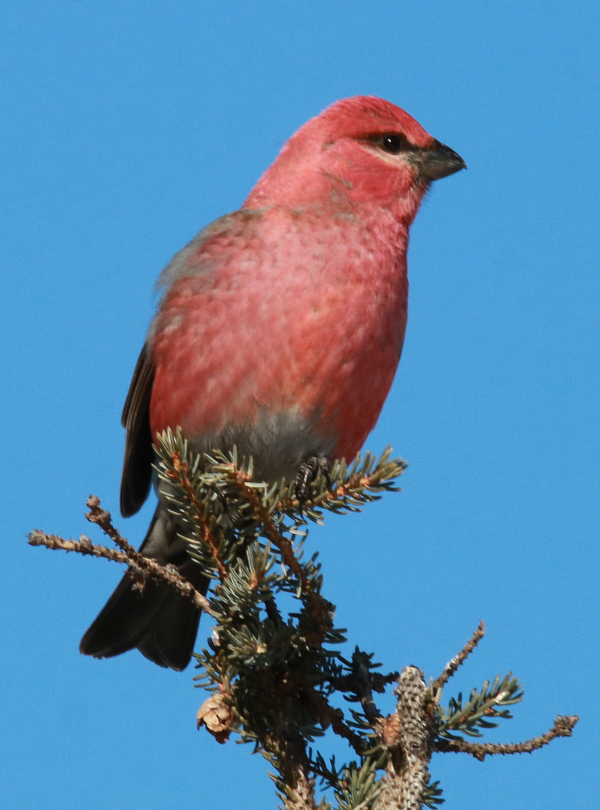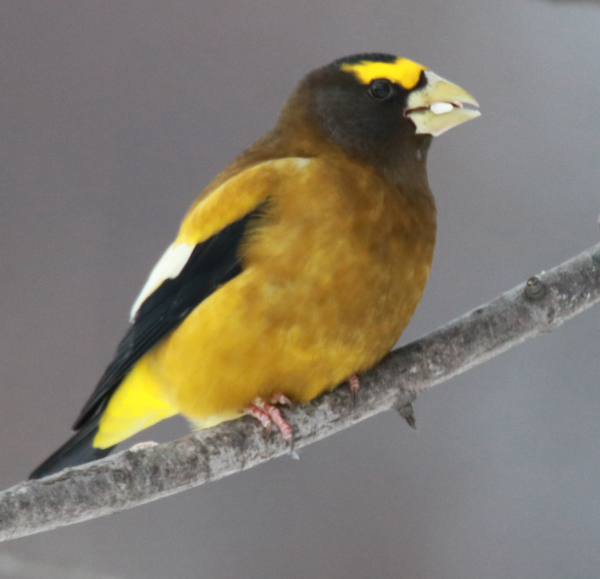
A Pine Grosbeak and Evening Grosbeak are two of the larger, more colorful “finches” we all hope to see this fall and winter (photos by Paul Konrad).

|
The potential of attracting colorful Purple Finches, Pine Grosbeaks and Evening Grosbeaks, Red Crossbills and White-winged Crossbills, Pine Siskins, Redpolls, and more should be ample incentives to keep your feeders filled with their favorite seeds and provide winter water. There’s a promising Finch Forecast for significant movements of northern finches and other boreal-nesting birds to southern Canada and many northern states, provided by the Finch Research Network. The annual Finch Forecast is always interesting and helpful when planning ahead.
It's an annual highlight that birders across North America look forward to each fall, and this year Tyler Hoar has prepared the 25th Annual Winter Finch Forecast. Tyler collects information from a network of contributors – the many birders, naturalists, biologists, and foresters whose tree seed production reports are essential to make this forecast. The forecast is, however, mostly limited to the eastern half of the continent, but it’s safe to expect that similar levels of movements south by the birds listed can be expected west of the Great Plains.
Backyard birders can benefit from this report by being prepared for the possibility that some of the exciting “finches” will venture into your area. To be on the safe side regarding the northern finches, it’s important to provide the 2 most important seeds you can offer at any feeding station – black oil sunflower seeds and thistle seeds, provided in separate feeders. Winter water, heated if necessary, is an important attraction too, as well as an important benefit for the birds during cold weather months. The favored finch seeds and fresh water will obviously attract most other birds too, especially if you include suet in the mix. That said, here is a condensed version of this year’s Finch Forecast, provided species by species.
Pine Grosbeaks – Areas in the upper Midwest states and cities in western Canada may see flocks of grosbeaks searching for fruiting ornamental trees and well-stocked feeders with black oil sunflower seeds. In the eastern boreal forest, most Pine Grosbeaks will probably remain in that region with some Pine Grosbeaks moving into traditional wintering areas in southeast Canada and New England.
Evening Grosbeaks from northwest Ontario westward should move out of the boreal forest, looking for feeders in towns or suitable food sources farther south. Evening Grosbeaks in the mountains of western Canada may move southward as well. At platform feeders, Evening Grosbeaks prefer black oil sunflower seeds. East of Lake Superior there is a diverse and widespread food source available, so expect most Evening Grosbeaks to remain in the boreal forest and adjacent areas of central Ontario, southern Quebec, the Maritime provinces, New England states, and New York this winter.
Purple Finches have already made significant flights southward during mid-September as indicated by counts at the Hawk Ridge Hawkwatch at Duluth, Minnesota; this is undoubtedly a result of low to absent natural foods in forests of northwest Ontario and Manitoba. To the east of Lake Superior, native seeds are abundant and widespread with little evidence of Purple Finch movements. From the upper Midwest states westward there should be a stronger movement south through the middle of the United States. In the east, many Purple Finches are expected to overwinter in southern Canada and Northeast states. At feeders, Purple Finches prefer black oil sunflower seeds.
White-winged Crossbills can be expected to make nomadic movements in small flocks coming south in search of food, so additional movements may be seen this winter into areas like southeast Canada and the Northeast states, as well as upper Midwest States and southern Manitoba.
Red Crossbills have already started invading the Great Lakes area, Ontario, Maritime provinces, and Northeast states, so watch for small flocks throughout fall and winter in those areas and beyond.
Pine Siskins have been leaving the boreal forest in significant numbers since mid-September, with thousands reported daily at migration monitoring stations from Duluth, Minnesota east to Tadoussac, Quebec. With poor natural foods for siskins in the boreal forest, there should be a moderate to possibly strong flight of Pine Siskins southward this fall. They prefer thistle seeds at feeding stations.
Common Redpolls are expected in moderate numbers south of the boreal forest. Watch for redpolls on birch trees, in weedy fields, and at bird feeders offering thistle seeds and black oil sunflower seeds.
As for other irruptive birds that primarily nest in the boreal forest, Red-breasted Nuthatches will not move far beyond the northern forest this season due to ample food resources, which is most likely for Bohemian Waxwings too. However, in areas west of Lake Superior there should be more widespread movements of flocks of Bohemian Waxwings.
To review the entire Winter Finch Forecast and other interesting information provided by the Finch Research Network, see 25th ANNUAL WINTER FINCH FORECAST (2023) - FINCH RESEARCH NETWORK (finchnetwork.org)
Share your backyard birding experiences and photographs with The Birding Wire at editorstbw2@gmail.com